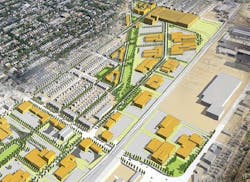A graphic rendering of the Century City business park. Graphic courtesy of the Milwaukee Department of City Development
Leslie Shown, of the Wisconsin Energy Institute, describes a University of Wisconsin-Madison microgrid research project that could help bolster Milwaukee’s ailing economy.
On the same site in Milwaukee where the A. O. Smith Corporation once built airplane and auto parts for the military during both world wars, University of Wisconsin-Madison energy researchers are using state-of-the-art microgrid technology to help revitalize Milwaukee’s power industry.
UW-Madison engineers Bruce Beihoff, Tom Jahns, and Robert Lasseter are teaming up with the Mid-West Energy Research Consortium (M-WERC) to design a microgrid-based electric power and distribution system to support Milwaukee’s Century City Business Park. Century City is designed to serve advanced manufacturing and research in Wisconsin’s largest industrial cluster, the energy, power, and control industries.
City planners hope that Century City will also bring increased economic stability to a city whose poverty rate currently approaches 30 percent. “The city of Milwaukee is working hard to attract businesses that will maximize job creation while paying family-supporting wages,” says Benji Timms, Century City project manager for Milwaukee’s Department of City Development.
A microgrid is a small, self-contained electric power system that can seamlessly connect and disconnect from the traditional power grid. The microgrid’s ability to function independently and cooperatively with the grid contributes to system stability and reliability and also allows customers and utilities to save energy by using waste heat and generating electricity locally when needed.
“The electric power and distribution system is the lifeblood of any type of advanced manufacturing or industrial research and development,” says Beihoff, technical director of industry relations at UW-Madison’s Wisconsin Energy Institute and director of technology innovation at M-WERC. “This project will equip Century City with the kind of reliable, clean, cost-effective and highly adaptable energy system that its specialized tenants require.”
It can be difficult for advanced manufacturing companies to find facilities designed with their specialized needs in mind. As a result, Century City has proven highly attractive to current tenants like Benson Industries. The Portland, Ore.-based company is manufacturing large, energy-efficient glass panels that will form the exterior wall of Northwestern Mutual Life Insurance Co.’s 32-story office building currently under construction in downtown Milwaukee.
“The Century City Business Park provides a large site that can acommodate industrial users with unique power and utility requirements,” says Timms.
Beihoff, Jahns and Lasseter say they are delighted to contribute to Century City’s development as a regional technology and industrial center. Other project partners include the Wisconsin Economic Development Corporation, the Wisconsin Energy Conservation Corporation, UW-Milwaukee, WE Energies, private real estate developers, engineering firms, and numerous other state and federal agencies.
This article is reposted from the University of Wisconsin-Madison News.







